April 4, 2015 – California is America’s market garden, the nation’s fruit and vegetable basket. It produces:
- 99% of the artichokes.
- 99% of the walnuts.
- 98% of the pistachios
- 97% of the kiwis.
- 97% of the plums.
- 96% of the figs.
- 95% of the celery.
- 95% of the garlic.
- 94% of the celery.
- 92% of the lemons.
- 91% of the grapes.
- 91% of the fresh strawberries.
- 90% of the broccoli.
- 89% of the cauliflower.
- 88% of the apricots.
- 88% of the avocados.
- 85% of the leaf lettuce.
- 82% of the dates.
- 74% of the raspberries.
- 73% of the honeydew melons.
- 73% of the peaches.
- 70% of the olives.
- 69% of the carrots.
- 43% of the green onions.
- 35% of the fresh tomatoes.
- 29% of the oranges.
- 25% of the onions.
- 25% of the pears.
In fact, more than 50% of all the fruit, nuts and vegetables grown in the United States originate from California representing 50% of the total fruit and tree nut farm value and 51% of vegetable farm value. It is the leading dairy state producing more milk and cream than any other part of the country. Its leading export crop is almonds, closely followed by grapes. This dominance is, in part, due to significantly better yields per hectare than other regions of the country and the ability to grow and harvest year round. Spinach yields in California are 60% higher than the national average. Lemon yields 50% higher. Without California the United States and Canada (the latter imports much of its winter produce from Central Valley farms) would do without.
California’s precarious future as the dominant agricultural state was particularly noticeable to me this year when I went about my usual habit of buying a bag of dried apricots about once a month. My wife eats a handful of the dried fruit every day and the local supermarket imports its entire supply from California growers. In the summer of 2014 a 500 gram bag of dried apricots cost $7.99 Canadian. By early fall the price had climbed to $9.99 and then $12.99 and finally $17.99. The reason, California growers were being impacted by what is increasingly being referred to as a mega-drought.
In the last week the Governor of California instituted water usage restrictions for the entire state. That’s because the major natural source of surface freshwater, the Sierra Nevada Mountain snow pack when measured on April 1 was 6% of normal. What does 6% of normal look like? The image below taken by Max Whittaker of skiers at Squaw Valley tells it all – a little bit of snow and a lot of bare ground.
Another picture appeared in newspapers around the world this week. Taken by Rich Pedroncelli it shows a rapidly declining Oroville Lake, California. The high water mark appears like a giant brown bathtub ring going halfway up the hillside slope surrounding what is quickly turning from a recreational lake to a dry lake bed.
In the Governor’s announcement he instituted an immediate mandatory 25% reduction on freshwater usage for 90% of California businesses and homeowners. No more frequent watering of lawns, golf courses, or washing down sidewalks.
But the Governor exempted large farms from the restrictions. The farmers, however, were asked to provide water usage data regularly to determine where water was being wasted.
The evidence is mounting that this four-year long drought is the beginning of something far more significant and the implications for North America’s market garden state are ominous. Past evidence from tree rings has shown that episodic droughts are common to the American Southwest. Some of these droughts have lasted multiple decades. If that is the case the farms of California may succumb to the same forces of nature that archeologists believe ended the civilization of the Anasazi, a native American culture that vanished from Arizona and New Mexico rather precipitously in the late 13th century.
This once thriving culture dating back to as early as 1500 BCE may have finally failed because of water stress and even water wars as neighbours competed for a declining resource.
Today drought conditions in the Central Valley and Central Coast districts of California are at exceptional levels. These two areas produce almost half the total value of farm produce in the state. Most are using irrigation drawing more frequently on well water from the underlying aquifer. The wells are getting deeper and deeper as farmers try to do business as usual. But business as usual in California is no longer possible.
Farmers are making some tough decisions – grow or don’t grow. Change what is grown. Invest in new drip irrigation technologies or dig more wells. Pray for rain and hope it isn’t deluge that erodes and wipes out your fields. The Governor in not targeting farms is delaying the inevitable because it is the farms that use 80% of the state’s freshwater.
California climate scientists believe the drought is here to stay with dire consequences by the mid 21st century. The Sierra Nevada snow pack is expected to drop to 40% of historical averages by the end of the century. That means the current farming infrastructure cannot continue as is. The farmers have been trying to adapt to declining freshwater and today use 2 million acre-feet less than 25 years ago and growing twice as much from the same water amount. But that California wine you like, which requires over 1,000 liters (275 gallons) of freshwater to produce one bottle may soon become a memory.
Thomas Kostigan last year wrote in National Geographic that the current drought bears a strong resemblance to the one that may have impacted the Anasazi some 700 to 800 years ago. He cites paleoclimatologist, Lynn Ingram, University of California, Berkeley, who sees evidence of a similar phenomenon in the medieval period and that California’s current situation could last two centuries or more.
Ingram points to surface temperatures in the Pacific Ocean and something called the Pacific Decadal Oscillation (PDO). Similar to El Nino and La Nina events but lasting far longer than a year, the PDO can stretch for decades producing cooler ocean surface temperatures which change atmospheric circulation. The observed Jet Stream migration to the north of California and the Southwestern United States is the end result.
The problem is the California of the 20th century was far wetter than normal when looking at long term climate records. The California emerging in the 21st century is more the norm. Ingram notes that prolonged PDOs over the last several thousand years have produced significant droughts for the entire Southwestern United States and California has born the brunt of these oscillations.
Is there a technology fix in the offing? Can smart irrigation achieve 25% water reductions and save California’s farms? Or will massive investments in desalination and grey water recycling continue to keep the state’s agricultural economy afloat?
Or will California produce the first wave of U.S. climate change refugees as farmers abandon homesteads like the one pictured below near Bakersfield, Central Valley, moving east in a reversal of those poignant scenes from John Steinbeck’s novel, “The Grapes of Wrath?”
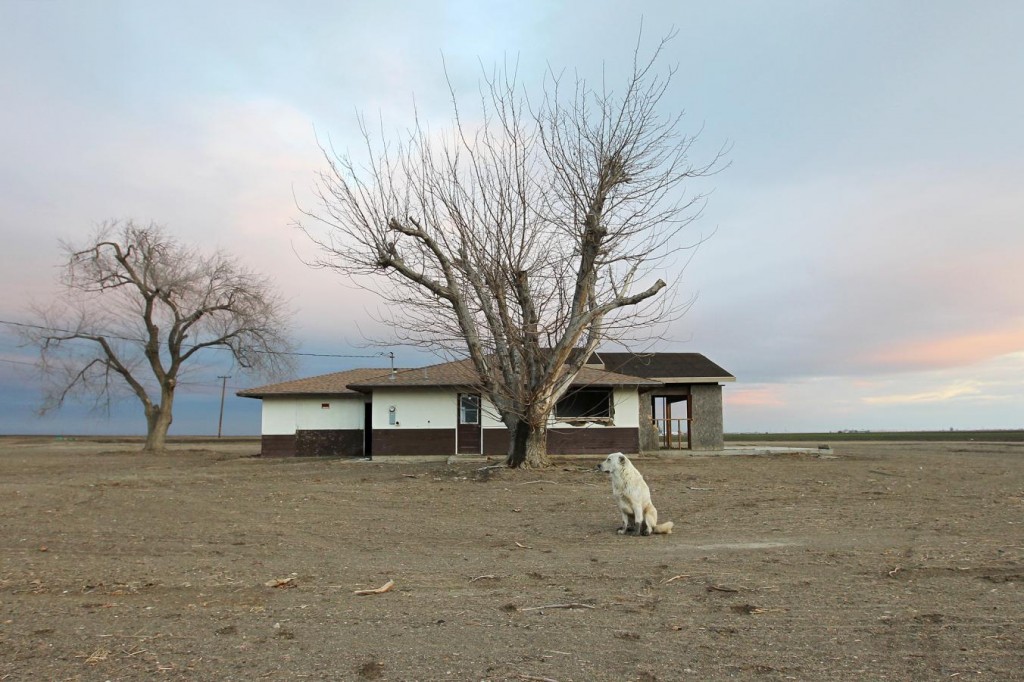
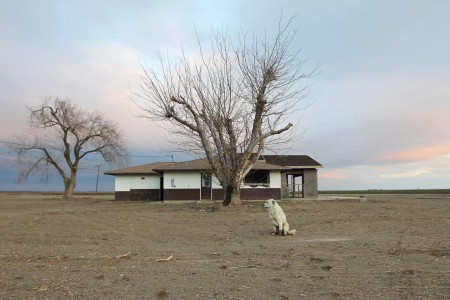
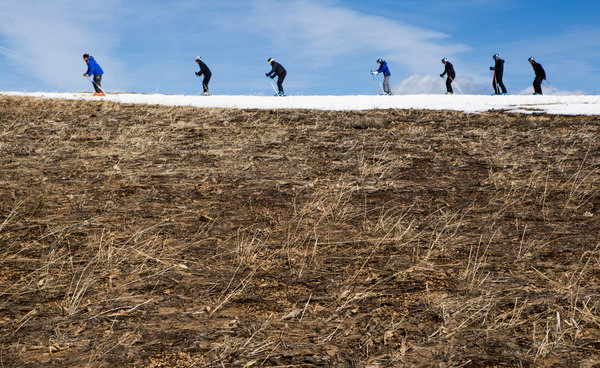
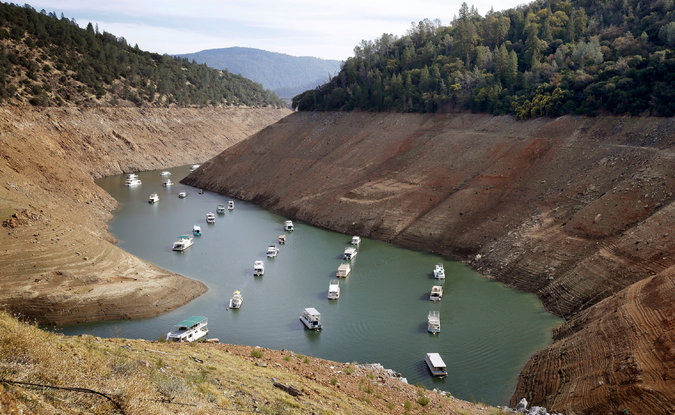
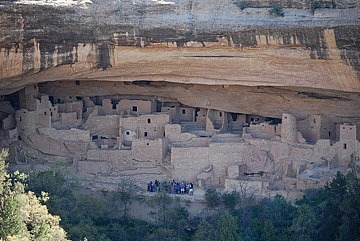














[…] prime growing region. According to California’s Department of Food and Agriculture, it produces more than one-third of vegetables and two-thirds of the fruit and nuts grown and consumed in the US […]
[…] into productive fields. The aquifer under California’s Central Valley has made that state the market garden capital of the country. Aquifers, however, can be drained through excessive water demand, and droughts can make surface […]